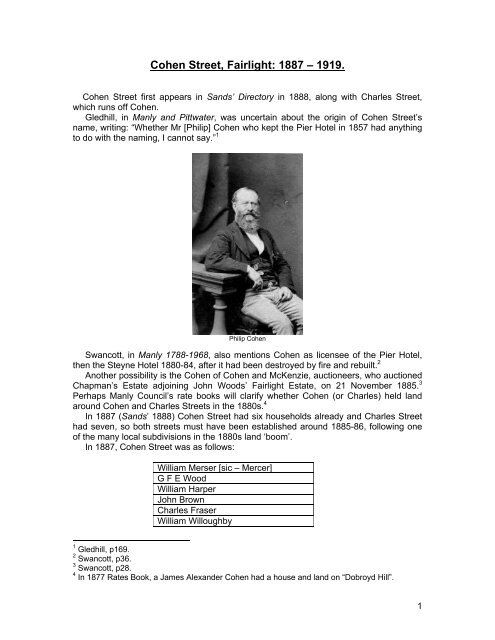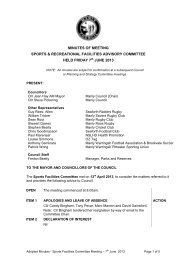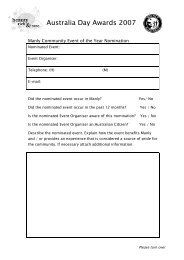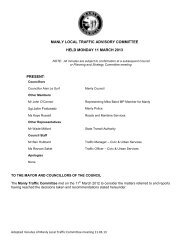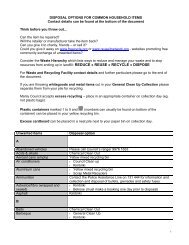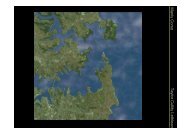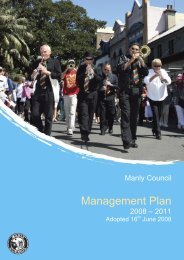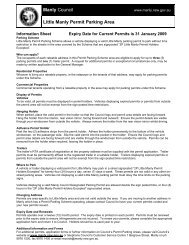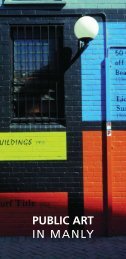Cohen Street, Fairlight: 1887 â 1919 - Manly Council
Cohen Street, Fairlight: 1887 â 1919 - Manly Council
Cohen Street, Fairlight: 1887 â 1919 - Manly Council
- No tags were found...
Create successful ePaper yourself
Turn your PDF publications into a flip-book with our unique Google optimized e-Paper software.
<strong>Cohen</strong> <strong>Street</strong>, <strong>Fairlight</strong>: <strong>1887</strong> – <strong>1919</strong>.<strong>Cohen</strong> <strong>Street</strong> first appears in Sands’ Directory in 1888, along with Charles <strong>Street</strong>,which runs off <strong>Cohen</strong>.Gledhill, in <strong>Manly</strong> and Pittwater, was uncertain about the origin of <strong>Cohen</strong> <strong>Street</strong>’sname, writing: “Whether Mr [Philip] <strong>Cohen</strong> who kept the Pier Hotel in 1857 had anythingto do with the naming, I cannot say.” 1Philip <strong>Cohen</strong>Swancott, in <strong>Manly</strong> 1788-1968, also mentions <strong>Cohen</strong> as licensee of the Pier Hotel,then the Steyne Hotel 1880-84, after it had been destroyed by fire and rebuilt. 2Another possibility is the <strong>Cohen</strong> of <strong>Cohen</strong> and McKenzie, auctioneers, who auctionedChapman’s Estate adjoining John Woods’ <strong>Fairlight</strong> Estate, on 21 November 1885. 3Perhaps <strong>Manly</strong> <strong>Council</strong>’s rate books will clarify whether <strong>Cohen</strong> (or Charles) held landaround <strong>Cohen</strong> and Charles <strong>Street</strong>s in the 1880s. 4In <strong>1887</strong> (Sands’ 1888) <strong>Cohen</strong> <strong>Street</strong> had six households already and Charles <strong>Street</strong>had seven, so both streets must have been established around 1885-86, following oneof the many local subdivisions in the 1880s land ‘boom’.In <strong>1887</strong>, <strong>Cohen</strong> <strong>Street</strong> was as follows:William Merser [sic – Mercer]G F E WoodWilliam HarperJohn BrownCharles FraserWilliam Willoughby1 Gledhill, p169.2 Swancott, p36.3 Swancott, p28.4 In 1877 Rates Book, a James Alexander <strong>Cohen</strong> had a house and land on “Dobroyd Hill”.1
Several of these households appear to have had links with established families in<strong>Manly</strong> and Balgowlah: William Mercer was likely related to Andrew Mercer, stonemason,who built and lived in Edinboro, Sydney Road; Charles Fraser was probably the brotherof the builder and contractor David Fraser of Fraser Villa, in Eustace <strong>Street</strong>, <strong>Manly</strong>.William F Harper was a baker, perhaps with a small bakery in <strong>Cohen</strong> <strong>Street</strong>, as heremained there right through to his death in 1925 5 . Several households were involved inthe building industry: the Mercers; Frasers; G F E Wood, a carpenter from Leichhardt(Sands’ <strong>1887</strong>); and William Willoughby, a carpenter from West Promenade, <strong>Manly</strong>(Sands’ <strong>1887</strong>). Wood was listed in 1894 (Sands’ 1895) as a draughtsman, still living in<strong>Cohen</strong> <strong>Street</strong>.House construction was in full swing nearby in the late 1880s. Around the corner inCharles <strong>Street</strong>, were other construction industry workers: Walter Arnold, stonemason;John Goss, plumber; and M George, carpenter.It appears that both <strong>Cohen</strong> and Charles <strong>Street</strong> provided low income housing forworking-class families and struggling tradesmen, a number with local roots. In additionto the Mercer and Fraser households, William Waters [sic – Waterer] had come fromRaglan <strong>Street</strong>, <strong>Manly</strong>, to Charles <strong>Street</strong>; William Willoughby from West Promenade to<strong>Cohen</strong> <strong>Street</strong>; Walter Arnold from Raglan to Charles <strong>Street</strong>; James Clarke from Eustaceto Charles; and Charles Collins, gardener, from Sebastopol <strong>Street</strong> (ie, part of what alsobecame Sydney Road) to Charles <strong>Street</strong>.By 1889 (Sands’ 1890), <strong>Cohen</strong> <strong>Street</strong> “off Middle Harbour Road” (ie off part of whatbecame Sydney Road) had five households:Charles Skinner [fisherman – son of BenjaminSkinner, boatman]William MercerG F E Wood [carpenter/draughtsman]William Harper [baker]J J Higgley [sic – Higley], undertakerThe land boom had collapsed, and both <strong>Cohen</strong> and Charles <strong>Street</strong> households feltthe impact of the 1890s Depression. While several of the building tradesmen wereforced out of the area, an unusual concentration of bakers continued, both in <strong>Cohen</strong> andCharles <strong>Street</strong>: William Harper (Sands’ 1888 on); William Archer (1890 on); R C Perry(1890 on); John Lawson (1895 on).Also noteworthy were the <strong>Manly</strong> police constables who lived in Charles <strong>Street</strong>: W JOrr (circa 1890) and Edward Clibborn (circa 1895).By 1894 (Sands’ 1895), <strong>Cohen</strong> <strong>Street</strong> still had only five households:Charles Skinner, fishermanWilliam MercerG F E Wood, draughtsmanWilliam F Harper, bakerJohn Lawson, baker 6Charles <strong>Street</strong> had only four households, down from seven listed in <strong>1887</strong> (Sands’ 1888).5 Aged 73. His grave is in <strong>Manly</strong> Cemetery, plot Z677, General Section.6 Died 1911 aged 72, buried <strong>Manly</strong> Cemetery General Section, Plot U183. A photocopy of hishand-written Recipe Book containing baker’s recipes is in the Wellings Collection at LS W 641.5.2
Of all the five households in <strong>Cohen</strong> <strong>Street</strong>, four had lived there five years or more;compared to only one in seven in Charles <strong>Street</strong>. It appears that four of the thirteenhouses listed in <strong>1887</strong> were vacant in 1894, underlining how hard the depression had hit.By 1899 (Sands’ 1900), <strong>Cohen</strong> <strong>Street</strong> was showing renewed life, with eighthouseholds listed, while <strong>Cohen</strong> <strong>Street</strong> had only four. The first house names had begunto appear locally: William Archer’s Strathspey in Charles <strong>Street</strong> was first (Sands’ 1890),followed by John Reid’s Annandale in <strong>Cohen</strong> <strong>Street</strong> (Sands’ 1900); and Edward “Happy”Eyre’s View Cottage in <strong>Cohen</strong> (Sands’ 1902).John Reid had come to <strong>Cohen</strong> <strong>Street</strong> from Young <strong>Street</strong>, Annandale (Sands’ 1898)hence his chosen house name. Happy Eyre was to make a significant contribution tothe history of surf lifesaving in Australia, as Swancott recounts: 7“The Sly brothers owned the first surfboat to be used for lifesaving on <strong>Manly</strong> OceanBeach. William Alfred Sly (“Tod”) went to Sydney, ordered a life belt and was measuredfor the first one used on the Ocean beach. He was the first man to don the belt andshow the few early morning bathers how to work both line and belt. By means of somedummy rescues by Tod, E[dward] Eyre and others, the present idea of rescue by beltand line was put into practice… For years, “Happy” Eyre was the only lifesaveremployed by the <strong>Council</strong> on the beach”.Fred Eyre, Happy’s son, represented <strong>Manly</strong> at rugby union and was a leadingprofessional golfer, who played at the opening of Balgowlah Golf Club’s new clubhousein 1926.At Federation in 1901, <strong>Cohen</strong> and Charles <strong>Street</strong>s were as follows (Sands’ 1902):-<strong>Cohen</strong> <strong>Street</strong> (from Sydney Road)E[dward] Eyre, View CottageJohn Reid, AnnandaleWilliam F Harper, bakerJohn LawsonJ BorthwickJ McPhersonJohn PhillipsCharles <strong>Street</strong> (from <strong>Cohen</strong> <strong>Street</strong>)Mrs J Clarke [widow of James Clarke]B MurrayW[illiam] WatererJ[osiah] TrenerryF MurrayJohn ConwellC LeonardJohn HowesArthur CroallJosiah Trenerry, a printer and future editor of the <strong>Manly</strong> Daily and <strong>Manly</strong> Alderman,had moved up from Victoria, but must have struggled to survive in the depressedeconomic conditions of the late 1890s. By the early 1900s, Trenerry was able to movefrom the battlers’ blocks in Charles <strong>Street</strong>, around the corner into <strong>Cohen</strong> <strong>Street</strong>.As prosperity gradually returned in the years between Federation and the Great War,<strong>Cohen</strong> <strong>Street</strong> first stabilized at around eight households in 1904 (Sands’ 1905), thensteadily increased to twelve households in 1914 (Sands’ 1915). The first female headsof household began to appear in Sands’. By 1904 (Sands’ 1905) there was Mrs JamesSaunders in <strong>Cohen</strong> <strong>Street</strong>, and Mrs A Murray and Mrs Mary Clark in Charles <strong>Street</strong>.In <strong>Cohen</strong> <strong>Street</strong>, Sands’ 1905 distinguished “east” and “west” sides of the street, asfollows (from Sydney Road):-7 Swancott, p161. He died 1938 aged 69 and is buried in <strong>Manly</strong> Cemetery, Plot N135.3
EastJohn LawsonJohn PhillipsWestJohn McPhersonMrs James SaundersJosiah TrenerryWilliam F Harper, bakerJohn HowesNorbert BoughtonHappy Eyre had moved from <strong>Cohen</strong> to Charles <strong>Street</strong>; while Trenerry had moved fromCharles to <strong>Cohen</strong>.In 1909 (Sands’ 1910), Charles <strong>Street</strong> received house numbers but <strong>Cohen</strong> <strong>Street</strong> didnot (it was still unnumbered in Sands’ 1920). Charles <strong>Street</strong> was complete by this time,with small weatherboard, brick and stone cottages on narrow blocks facing only thenorth side of the street (* indicates female head of household):-Charles <strong>Street</strong> (from William <strong>Street</strong>1 Albert Edwards3 James Dilling5 James Edwards7 John Baker9 William Christie11 George Wollett13 Robert D Murray15 Mrs Mary Clark*17 Mrs Cottle*19 Mrs Travers*21 Mrs A Murray*Charles <strong>Street</strong> appears to have attracted a number of widows who could make a livingoffering rooms to let or running cheap boardinghouses for workmen. The Murrays hadbeen in Charles <strong>Street</strong> since Federation. Happy Eyre had moved out.In <strong>Cohen</strong> <strong>Street</strong> in 1909, apart from the “pioneer” baker William Harper, the widowedMrs John McPherson remained, along with another descendant of the prominent Skinnerfamily, Arthur Skinner, whose brother(?) Charles had lived there in 1894.Between 1909 and 1914, <strong>Cohen</strong> <strong>Street</strong> added four households, three on the eastside. The widowed Mrs J[ohn] Lawson was joined by Mrs Ada Bennett, in Bolton on theeast side; while the widowed Mrs Jennie McPherson was joined by Mrs Hawker inAnnandale, and Mrs Richard Friend in Gordon. Josiah Trenerry JP remained.In 1914 (Sands’ 1915), there were eight female householders in <strong>Cohen</strong> and Charles<strong>Street</strong>s – an extraordinarily high proportion of the 23 households. This suggests aconcentration of rooms to let and boarding houses in both streets, especially in <strong>Cohen</strong><strong>Street</strong> near Sydney Road with the new tramway between <strong>Manly</strong> and The Spit.During and after World War One, <strong>Cohen</strong> <strong>Street</strong> continued to grow as more semiswere built north toward Griffiths <strong>Street</strong>. The steep hill and distance from the SydneyRoad trams made this land less desirable and, therefore, cheaper. Between 1914 and<strong>1919</strong> (Sands’ 1920), <strong>Cohen</strong> <strong>Street</strong> added six houses, a 50% growth. In <strong>1919</strong> it lookedas follows, from Sydney Road (still without street numbers):-4
North (formerly east)South (formerly west)(off 122 Sydney Road)J J MurrayMrs Emma McPherson*Miss Jane McPherson*Mrs J Lawson*Walter Stere [Steer?]A[rchibald] R May (off) Paget Bayly 8Mrs Ada Bennett*William SheedyJohn PhillipsPeter SutherlandFrederick PerkinsWilliam F Harper [retired? baker]Charles <strong>Street</strong>Corrick and Molesworth [carriers?]Arthur AndersonMrs Rhoda Lewis*William H HerbertsGriffith <strong>Street</strong>Jamieson Bros [J & S Jamieson in 1922]There were still five female householders in <strong>Cohen</strong> <strong>Street</strong>, but two of those in 1914had moved by <strong>1919</strong>. Josiah Trenerry, now owner of The <strong>Manly</strong> Free Press, had alsomoved as his printing and publishing business prospered – to high status LauderdaleAvenue, <strong>Manly</strong>.The first significant businesses were capitalizing on <strong>Cohen</strong> <strong>Street</strong>’s location on theoutskirts of a fast-growing <strong>Manly</strong>. <strong>Cohen</strong> <strong>Street</strong> was no longer in the “back-blocks” butsoon to be close to the <strong>Fairlight</strong> shopping centre developed in the 1920s.By 1925 (Sands’ 1926), <strong>Cohen</strong> <strong>Street</strong> was beginning to have street numbers, whilethe increasing frequency of house names suggested a more ‘established’ feel to thestreet. However, there was still only one house beyond Charles <strong>Street</strong> on the north side.NorthSouth(off 122 Sydney Road)1 H E Pearce, Denanah2 William J Day 3 G Driver, Bettincourt4 Mrs J Lawson, Dalmahoy 5 Walter DriverMiss M Lawson, costumiere [7] A[lex] A Currie, Wendouree 9Archibald R May[9] A S Ferri, AlbemarleMrs E Dean, BoltonWilliam F Harper[10] J Phillips, Kirkliston Arthur F Anderson, Gordon 10J Gillespie, BegaThomas Gray, BramleighCharles <strong>Street</strong>W H Herberts, LemnosMrs Mary Buckley [Meridor]Mrs D Lane, PlymouthGriffiths <strong>Street</strong>J & S Jamieson, buildersWhile several families like the Lawsons, Phillips 11 and Drivers had put down newroots, only William Harper (now presumably retired) lived on in <strong>Cohen</strong> <strong>Street</strong>, forty yearsafter first taking up residence as the local baker.8 Paget Bayly died 1925, aged 76, and is buried in Plot U364 of <strong>Manly</strong> Cemetery.9 Alex Currie died 1929 aged 82, and is buried in Plot Z214 of <strong>Manly</strong> Cemetery.10 Arthur Anderson died 1933, aged 51, and is buried in Plot Z851 of <strong>Manly</strong> Cemetery.11 John Phillips died 1933, aged 72; his wife Annie died 1931 aged 78. They are buried in PlotS403 of <strong>Manly</strong> Cemetery.5
J & S Jamieson, builders, gave their name to Jamieson Avenue, Balgowlah, offSuwarrow <strong>Street</strong>, near the site of their builders’ yard which in the 1920s stood near thecorner of <strong>Cohen</strong> and Griffiths <strong>Street</strong>s.By 1930 (Sands’ 1931) several houses, including Albemarle (no 9) and Plymouth hadbeen subdivided into flats. William Harper had died in 1925 and his house was vacant,as were a number of others with the Great Depression beginning to bite. <strong>Cohen</strong> <strong>Street</strong>in 1930 had less occupied houses (15) than in <strong>1919</strong> (18). While still a step or two on thesocial ‘ladder’ above Charles <strong>Street</strong>, the ever-changing residents of <strong>Cohen</strong> <strong>Street</strong> wereto experience many more lean years before prosperity returned in the late 1950s.Terry MetherellJune 2005.6


